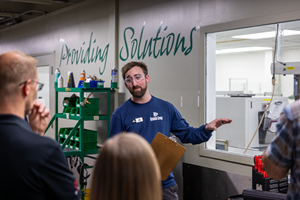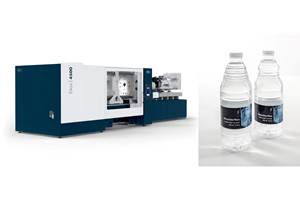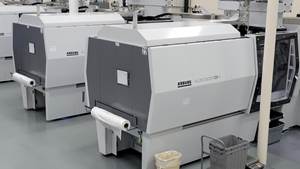Electronic Flow Monitoring Gives Medical Molder a Better Handle on Mold Cooling
Monitoring water flow and temperature in individual channels proves a valuable tool for process validation and troubleshooting.
For many injection molders, mold cooling is plagued with unknowns—namely, what are the coolant flow and temperature in each individual cooling channel in multicavity molds. “It was the missing piece of the puzzle,” says the engineering manager at a major U.S. medical molder. Now, this molder has found that missing piece, thanks to electronic flow monitoring with the Flowcon Plus system from Wittmann Battenfeld, Torrington, Conn. The result has been dramatic reductions in time for validating the cooling portion of the injection molding process and for troubleshooting problems when they occur, as well as cost and time savings from reductions in mold damage that can be caused by coolant flow disruptions inside the mold channels.
I recently visited that molder (which does not want to be identified) and got a first-hand explanation of how increased visibility of coolant flow inside the mold offers multiple benefits.
“We have a lot of 32-cavity syringe molds, and some with 64 cavities,” notes the engineering manager. “They have very small bubblers that can become easily blocked. If we get a hot core, the robot can’t pick the parts easily and can break the small cores. Insufficient cooling can also show up as burning on the parts.”
Until recently, he told me, his staff had no easy way to find out exactly where in the mold-cooling layout a blockage was occurring, and no way at all to see a cooling problem developing until it resulted in reject parts or mold damage.
For the past year, this plant has been exploring the capabilities of the Flowcon Plus electronic flow monitor, which measures coolant temperature and flow rate in each cooling channel separately. It also provides stepper-motor control of a valve for each channel to permit closed-loop flow control, but so far, this molder has not made use of that capability. The engineering manager is sufficiently impressed by the unit’s ability to show exactly where flow problems are occurring, and in real time. “It’s an impressive troubleshooting tool, helping us achieve less scrap and less downtime to solve problems. It’s awesome.”
At least as important is the flow monitor’s assistance in speeding validation of a new mold. Though mold exit temperature is the firm’s validation spec, the molder also uses flow measurement for setup. “For every new tool, we need to document all flows and in/out temperatures. Before now, we had to put a single flow meter on each channel separately for setup. The process could take a whole day. Now, with Flowcon Plus, we see the whole mold all at once. It eliminates two-thirds of the setup time.” Eventually, the molding manager says he’d like to see coolant flow as an additional validation spec.
He estimates that the electronic flow monitor paid for itself in four to six months through time savings, reduced scrap, and reduced tool damage. The plant has only one unit on a cart that allows it to be wheeled from press to press for mold setup, validation, and troubleshooting. But the manager would like to get more of these monitors so they could be left in place on the machines. Ten years from now, he speculates, electronic flow monitoring could be a company—or perhaps an industry—standard.
Related Content
Medical Molder, Moldmaker Embraces Continuous Improvement
True to the adjective in its name, Dynamic Group has been characterized by constant change, activity and progress over its nearly five decades as a medical molder and moldmaker.
Read MoreKrones Acquires Netstal
Krones adds PET preform injection molding to its bottle blowing and filling capabilities, as well as cap molding and expansion into medical, food and other markets.
Read MoreCompact Solution for Two-Component Molding
Zahoransky’s new internal mold handling technology foregoes the time, space and money required for core-back, rotary table or index plate technologies for 2K molding.
Read MoreConsistent Shots for Consistent Shots
An integral supplier in the effort to fast-track COVID-19 vaccine deployment, Retractable Technologies turned to Arburg and its PressurePilot technology to help deliver more than 500 million syringes during the pandemic.
Read MoreRead Next
Making the Circular Economy a Reality
Driven by brand owner demands and new worldwide legislation, the entire supply chain is working toward the shift to circularity, with some evidence the circular economy has already begun.
Read MoreBeyond Prototypes: 8 Ways the Plastics Industry Is Using 3D Printing
Plastics processors are finding applications for 3D printing around the plant and across the supply chain. Here are 8 examples to look for at NPE2024.
Read More
























